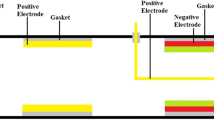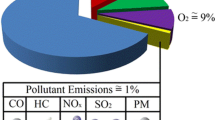Abstract
Due to the rise in vehicular emissions, the rapid deterioration of the atmospheric air quality is a cause for concern in a global scale. In this context, the objective of this study is to explore the effect of post-injection parameters on a continuous active regeneration trap (CART) to mitigate harmful greenhouse gases (GHG) and particulate smoke emissions (PSE) using diesel fuel reformulated by long-chain microalgae bio-alcohol and low-density microalgae biodiesel. Furthermore, the efficiency of the CART unit is analyzed based on its ability to mitigate the harmful emissions without sacrificing the engine performance characteristics. From the study, it was observed that the maximum de-smoke efficiency of 67.85% is observed at a post-injection timing (PIT) of 20°CA aTDC at a post-injection mass (PIM) of 4 mg for low load condition while operating on microalgae biodiesel. While operating on microalgae bio-alcohol, the maximum de-smoke CART efficiency was observed as 67.25% and 55.78% for low and medium load conditions at a PIT and PIM of 20°CA aTDC and 2 mg while operating on the microalgae bio-alcohol. Likewise, the maximum de-HC CART efficiency was obtained at a PIT and PIM of 10°CA aTDC and 1 mg with a reduction of about 75% and 73.8% for medium and high load conditions. A slight reduction in oxides of nitrogen with the complete elimination of carbon monoxide emissions is observed after CART treatment for both the fuels.
















Similar content being viewed by others
Data set
Not Applicable.
References
Apicella B, Mancaruso E, Russo C, Tregrossi A, Oliano MM, Ciajolo A, Vaglieco BM (2020) Effect of after-treatment systems on particulate matter emissions in diesel engine exhaust. Exp Thermal Fluid Sci 116:110107. https://doi.org/10.1016/j.expthermflusci.2020.110107
Atmanli A, Yilmaz N (2018) A comparative analysis of n-butanol/diesel and 1-pentanol/diesel blends in a compression ignition engine. Fuel 234:161–169. https://doi.org/10.1016/j.fuel.2018.07.015
Ayodhya AS, Narayanappa KG (2018) An overview of after-treatment systems for diesel engines. Environ Sci Pollut Res 25(35):35034–35047. https://doi.org/10.1007/s11356-018-3487-8
Chen C, Yao A, Yao C, Qu G (2020) Experimental study of the active and passive regeneration procedures of a diesel particulate filter in a diesel methanol dual fuel engine. Fuel 264:116801. https://doi.org/10.1016/j.fuel.2019.116801
Chung C, Geer L, Rajadurai S. (2000) Numerical simulation and experimental validation of the catalytic converter cool down process. SAE Technical Paper
Duraisamy B, Velmurugan K, Venkatachalapathy VK, Thiyagarajan S, Varuvel EG (2021) Effect of amyl alcohol addition in a CI engine with Prosopis juliflora oil–an experimental study. Energy Sources, Part a: Recovery, Util Environ Eff 1–15https://doi.org/10.1080/15567036.2021.1996489
El Shenawy EA, Elkelawy M, Bastawissi HA, Taha M, Panchal H, Kumar Sadasivuni K, Thakar N (2020) Effect of cultivation parameters and heat management on the algae species growth conditions and biomass production in a continuous feedstock photobioreactor. Renew Energy 148:807–15. https://doi.org/10.1016/j.renene.2019.10.166
ElKelawy M, Bastawissi HA, El-Shenawy ES, Panchal H, Sadashivuni K, Ponnamma D, Al-Hofy M, Thakar N, Walvekar R (2019) Experimental investigations on spray flames and emissions analysis of diesel and diesel/biodiesel blends for combustion in oxy-fuel burner. Asia-Pac J Chem Eng 14(6):e2375. https://doi.org/10.1002/apj.2375
Elkelawy M, Etaiw SE, Bastawissi HA, Marie H, Elbanna A, Panchal H, Sadasivuni K, Bhargav H (2020) Study of diesel-biodiesel blends combustion and emission characteristics in a CI engine by adding nanoparticles of Mn (II) supramolecular complex. Atmos Pollut Res 11(1):117–128. https://doi.org/10.1016/j.apr.2019.09.021
Elkelawy M, Bastawissi HAE, El Shenawy EA, Taha M, Panchal H, Sadasivuni KK (2021a) Study of performance, combustion, and emissions parameters of DI-diesel engine fueled with algae biodiesel/diesel/n-pentane blends. Energy Convers Manag: X 10:100058. https://doi.org/10.1016/j.ecmx.2020.100058
Elkelawy M, Etaiw SE, Ayad MI, Marie H, Dawood M, Panchal H, Bastawissi HA (2021b) An enhancement in the diesel engine performance, combustion, and emission attributes fueled by diesel-biodiesel and 3D silver thiocyanate nanoparticles additive fuel blends. J Taiwan Inst Chem Eng 124:369–80. https://doi.org/10.1016/j.jtice.2021b.02.019
Hesterberg TW, Long CM, Bunn WB, Lapin CA, McClellan RO, Valberg PA (2012) Health effects research and regulation of diesel exhaust: an historical overview focused on lung cancer risk. Inhalation Toxicol 24(sup1):1–45. https://doi.org/10.3109/08958378.2012.691913
Jacob A, Ashok B (2020) An interdisciplinary review on calibration strategies of engine management system for diverse alternative fuels in IC engine applications. Fuel 278:118236. https://doi.org/10.1016/j.fuel.2020.118236
Jacob A, Ashok B (2021a) Biosynthesis of amyl alcohol from Scenedesmus quadricauda microalgae for light commercial vehicle CI engine using prediction models. J Energy Res Technol 1–34https://doi.org/10.1115/1.4052542
Jacob A, Ashok B (2021b) Potential of amyl alcohol mixtures derived from Scenedesmus quadricauda microalgae biomass as third generation bioenergy for compression ignition engine applications using multivariate-desirability analysis. Energy Sources, Part a: Recovery, Util Environ Eff 1–19. https://doi.org/10.1080/15567036.2021.1950872
Jacob A, Ashok B, Ong HC, Le PTK (2022a) Scaling-up heterotrophic cultures of C. Pyrenoidosa microalgae for sustainable synthesis of low-density biodiesel mixtures and predict CI engine behavior at optimal proportions. Environ Dev Sustain 1–23. https://doi.org/10.1007/s10668-021-02060-1
Jacob A, Ashok B, Usman KM, Raja VB, Jino L (2022b) Synergistic effect of post injection and CART unit in extenuating tail-pipe pollutants in CI engine using C. pyrenoidosa microalgae biodiesel. Sustain Energy Technol Assess 52:102188. https://doi.org/10.1016/j.seta.2022b.102188
Jacob A, Ashok B, Usman KM (2022c) Production of Chlorella pyrenoidosa biodiesel by heterotrophic pathway to improve CI engine output characteristics using statistical approaches. Process Saf Environ Prot 160:478–90
Khiraiya K, Ramana PV, Panchal H, Sadasivuni KK, Doranehgard MH, Khalid M (2021) Diesel-fired boiler performance and emissions measurements using a combination of diesel and palm biodiesel. Case Stud Therm Eng 1(27):101324. https://doi.org/10.1016/j.csite.2021.101324
Kumbhar V, Pandey A, Sonawane CR, El-Shafay AS, Panchal H, Chamkha AJ (2022) Statistical analysis on prediction of biodiesel properties from its fatty acid composition. Case Stud Therm Eng 30:101775. https://doi.org/10.1016/j.csite.2022.101775
Lao CT, Akroyd J, Eaves N, Smith A, Morgan N, Nurkowski D, ... Kraft M (2020) Investigation of the impact of the configuration of exhaust after-treatment system for diesel engines. Appl Energy 267 114844 https://doi.org/10.1016/j.apenergy.2020.114844
Mera Z, Fonseca N, Casanova J, López JM (2021) Influence of exhaust gas temperature and air-fuel ratio on NOx after treatment performance of five large passenger cars. Atmos Environ 244:117878. https://doi.org/10.1016/j.atmosenv.2020.117878
Nutakki PK, Gugulothu SK, Ramachander J, Sivasurya M (2022) Effect Of n-amyl alcohol/biodiesel blended nano additives on the performance, combustion and emission characteristics of CRDi diesel engine. Environ Sci Pollut Res 29(1):82–97. https://doi.org/10.1007/s11356-021-13165-5
Pan M, Huang R, Liao J, Jia C, Zhou X, Huang H, Huang X (2019) Experimental study of the spray, combustion, and emission performance of a diesel engine with high n-pentanol blending ratios. Energy Convers Manage 194:1–10. https://doi.org/10.1016/j.enconman.2019.04.054
Rajak U, Nashine P, Singh TS, Verma TN (2018) Numerical investigation of performance, combustion and emission characteristics of various biofuels. Energy Convers Manage 156:235–252. https://doi.org/10.1016/j.enconman.2017.11.017
Rajamohan S, Kasimani R (2018) Studies on the effects of storage stability of bio-oil obtained from pyrolysis of Calophyllum inophyllum deoiled seed cake on the performance and emission characteristics of a direct-injection diesel engine. Environ Sci Pollut Res 25(18):17749–17767. https://doi.org/10.1007/s11356-018-1986-2
Rajasekar V, Geo VE, Martin LJ, Nagalingam B (2020) The combined effect of low viscous biofuel and EGR on NO-smoke tradeoff in a biodiesel engine—an experimental study. Environ Sci Pollut Res 27(15):17468–17480. https://doi.org/10.1007/s11356-019-05449-8
Rodríguez-Fernández J, Hernández JJ, Sánchez-Valdepeñas J (2016) Effect of oxygenated and paraffinic alternative diesel fuels on soot reactivity and implications on DPF regeneration. Fuel 185:460–467. https://doi.org/10.1016/j.fuel.2016.08.016
Santhosh K, Kumar GN (2020) Effect of 1-pentanol addition and EGR on the combustion, performance and emission characteristic of a CRDI diesel engine. Renew Energy 145:925–936. https://doi.org/10.1016/j.renene.2019.06.043
Soleimani M, Akbari N, Saffari B, Haghshenas H (2021) Estimation of economic costs of air pollution caused by motor vehicles in Iran (Isfahan). Environ Sci Pollut Res 28(47):66535–66555. https://doi.org/10.1007/s11356-021-13504-6
Solomon JM, Pachamuthu S, Arulanandan JJ, Thangavel N, Sathyamurthy R (2020) Electrochemical decomposition of NOx and oxidation of HC and CO emissions by developing electrochemical cells for diesel engine emission control. Environ Sci Pollut Res 27(26):32229–32238. https://doi.org/10.1007/s11356-019-07327-9
Uppalapati S, Jani SP, Khan MB, Alagarsamy M, Manoharan M, Panchal H, Sadasivuni KK (2022) A comparative assessment on life cycle analysis of the biodiesel fuels produced from soybean, Jatropha, Calophyllum inophyllum, and microalgae. Energy Sources, Part a: Recovery, Util Environ Eff 44(2):3253–3272. https://doi.org/10.1080/15567036.2022.2053248
Wei J, He C, Fan C, Pan S, Wei M, Wang C (2021) Comparison in the effects of alumina, ceria and silica nanoparticle additives on the combustion and emission characteristics of a modern methanol-diesel dual-fuel CI engine. Energy Convers Manage 238:114121. https://doi.org/10.1016/j.enconman.2021.114121
Wu Y, Wang P, Farhan SM, Yi J, Lei L (2019) Effect of post-injection on combustion and exhaust emissions in DI diesel engine. Fuel 258:116131. https://doi.org/10.1016/j.fuel.2019.116131
Wu B, Jia Z, Li Z, Liu G, Zhong X (2021) Different exhaust temperature management technologies for heavy-duty diesel engines with regard to thermal efficiency. Appl Therm Eng 186:116495. https://doi.org/10.1016/j.applthermaleng.2020.116495
Acknowledgements
The authors wish to thank the Department of Science Technology (DST), India, for funding this work under the scheme of the ASEAN-India Science & Technology Development Fund (AISTDF) for the project (CRD/2018/ 000061).
Author information
Authors and Affiliations
Contributions
Bragadeshwaran Ashok and Ashwin Jacob contributed to the conceptualization, investigation, data curation, and project administration. Material preparation, data collection, and analysis were performed by Ashwin Jacob and Bragadeshwaran Ashok. The first draft of the manuscript was written by Ashwin Jacob, Jino Lawrence, Arockia Suthan Soosairaj, Jayaganthan Anandan, and Manoj Elango. All authors read and approved the final manuscript.
Corresponding author
Ethics declarations
Ethical approval
Not applicable.
Consent to participate
Not applicable.
Consent for publication
Not applicable.
Competing interests
The authors declare no competing interests.
Additional information
Responsible Editor: Philippe Garrigues
Publisher's note
Springer Nature remains neutral with regard to jurisdictional claims in published maps and institutional affiliations.
Rights and permissions
Springer Nature or its licensor (e.g. a society or other partner) holds exclusive rights to this article under a publishing agreement with the author(s) or other rightsholder(s); author self-archiving of the accepted manuscript version of this article is solely governed by the terms of such publishing agreement and applicable law.
About this article
Cite this article
Jacob, A., Ashok, B., Lawrence, J. et al. Exploring the potential of third-generation microalgae bio-alcohol and biodiesel in arresting particulate smoke emissions and greenhouse gases using CART. Environ Sci Pollut Res 30, 27650–27669 (2023). https://doi.org/10.1007/s11356-022-24110-5
Received:
Accepted:
Published:
Issue Date:
DOI: https://doi.org/10.1007/s11356-022-24110-5




